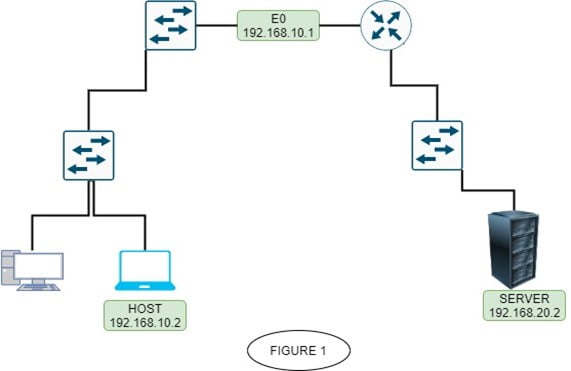HOW TO TROUBLESHOOT IP ADDRESSING?
Troubleshooting IP Addressing is undoubtedly an Important skill because being into trouble is common when you try to configure things. Troubleshooting is all about finding problems and then try to resolve them. But frankly resolving a problem is Pretty fine but first finding it is not that easy, so this is where I’m going to show you the ways of troubleshooting IP addressing.
Let’s use Figure1 as an example of basic IP trouble – Host can’t be able to log in to the Windows server

Okay, let’s begin by discussing the troubleshooting steps that one should follow. Assume you’re at a customer host and they are facing some issue that they are not able to communicate to the server that is just happening to be on a remote network.
Here are the four troubleshooting steps that are Recommendable
STEP 1: – First you will open the command window of your PC and Ping 127.0.0.1 is
Diagnostic or Loopback Address.
- If you get a successful Ping, then your PC’s IP stack is considered initialized then you can jump into the next step.
- But if the ping fails, then your PC has an IP stack failure and need to Reinstall
TCP/IP on the host by (admin)cmd = netsh int ip reset.
C:>ping 127.0.0.1
Pinging 127.0.0.1 with 32 bytes of data:
Reply from 127.0.0.1: bytes=32 time<1ms TTL=128
Reply from 127.0.0.1: bytes=32 time<1ms TTL=128
Reply from 127.0.0.1: bytes=32 time<1ms TTL=128
Reply from 127.0.0.1: bytes=32 time<1ms TTL=128
Ping statistics for 127.0.0.1:
Packets: Sent = 4, Received = 4, Lost = 0 (0% loss),
Approximate round trip times in milli-seconds:
Minimum = 0ms, Maximum = 0ms, Average = 0ms
STEP 2: – After that, you will Ping to the local host, or you can say your own Ip address from
your own command window.
- If the ping gets successful, then your Network Address Card (NIC) is functioning well. It indicates that the IP protocol stack on the host can communicate to the NIC (via the LAN driver).
- If the ping fails, then there is a problem with the NIC.
C:>ping 192.168.10.2
Pinging 192.168.10.2 with 32 bytes of data:
Reply from 192.168.10.2: bytes=32 time<1ms TTL=128
Reply from 192.168.10.2: bytes=32 time<1ms TTL=128
Reply from 192.168.10.2: bytes=32 time<1ms TTL=128
Reply from 192.168.10.2: bytes=32 time<1ms TTL=128
Ping statistics for 192.168.10.2:
Packets: Sent = 4, Received = 4, Lost = 0 (0% loss),
Approximate round trip times in milli-seconds:
Minimum = 0ms, Maximum = 0ms, Average = 0ms
STEP 3: – After that, you will ping the default gateway (router).
- If the ping gets successful, it means that your PC and can communicate on the local network
- If the ping fails, then you have a local physical network problem that can be anywhere between your PC to the Default Gateway (router).
C:>ping 192.168.10.1
Pinging 192.168.10.1 with 32 bytes of data:
Reply from 192.168.10.1: bytes=32 time<1ms TTL=128
Reply from 192.168.10.1: bytes=32 time<1ms TTL=128
Reply from 192.168.10.1: bytes=32 time<1ms TTL=128
Reply from 192.168.10.1: bytes=32 time<1ms TTL=128
Ping statistics for 192.168.10.1:
Packets: Sent = 4, Received = 4, Lost = 0 (0% loss),
Approximate round trip times in milli-seconds:
Minimum = 0ms, Maximum = 0ms, Average = 0ms
STEP 4: – If steps 1 to steps 3 were successful, now next step is to ping the remote server
- If the ping gets successful, then you have IP communication between the local host and remote server. You also get to know that your remote physical network is also working well.
C:>ping 192.168.20.2
Pinging 192.168.20.2 with 32 bytes of data:
Reply from 192.168.20.2: bytes=32 time<1ms TTL=128
Reply from 192.168.20.2: bytes=32 time<1ms TTL=128
Reply from 192.168.20.2: bytes=32 time<1ms TTL=128
Reply from 192.168.20.2: bytes=32 time<1ms TTL=128
Ping statistics for 192.168.20.2:
Packets: Sent = 4, Received = 4, Lost = 0 (0% loss),
Approximate round trip times in milli-seconds:
Minimum = 0ms, Maximum = 0ms, Average = 0ms
If the user is still can’t communicate with the server after steps 1 to 4 get successful, then you probably have a Remote physical server issue and now you need to go to the remote server and follow up all the steps from step 1 through step 4.
We hope these troubleshooting steps will be helpful for you. If your organization required any new implementation and to know how Zindagi can help solve your IT / Information Security-related problems. Please reach us on email or you can give us a call or whatsapp at +91 9773973971.
Author
Yash Kumar
Associate Consultant
